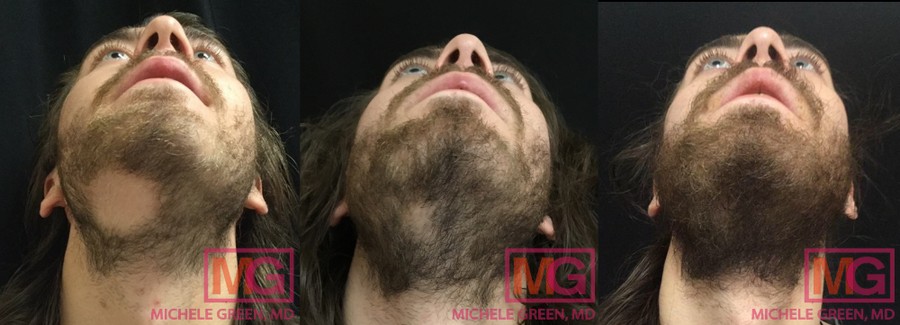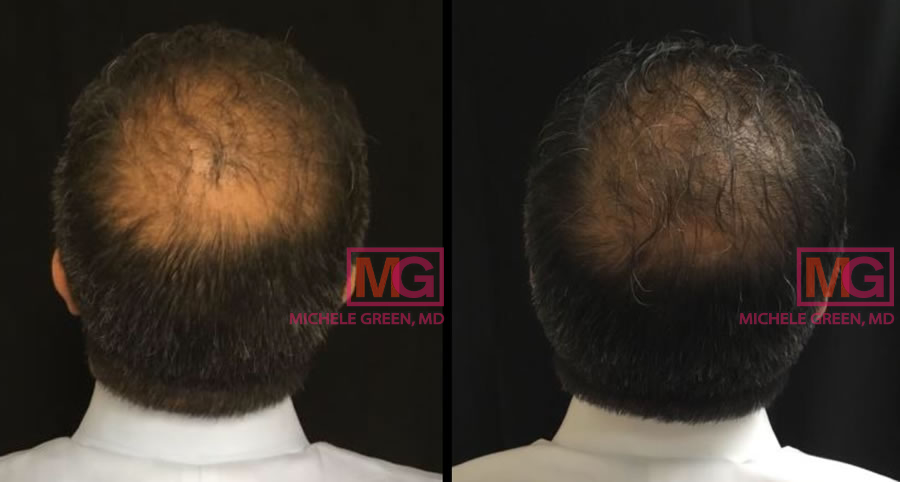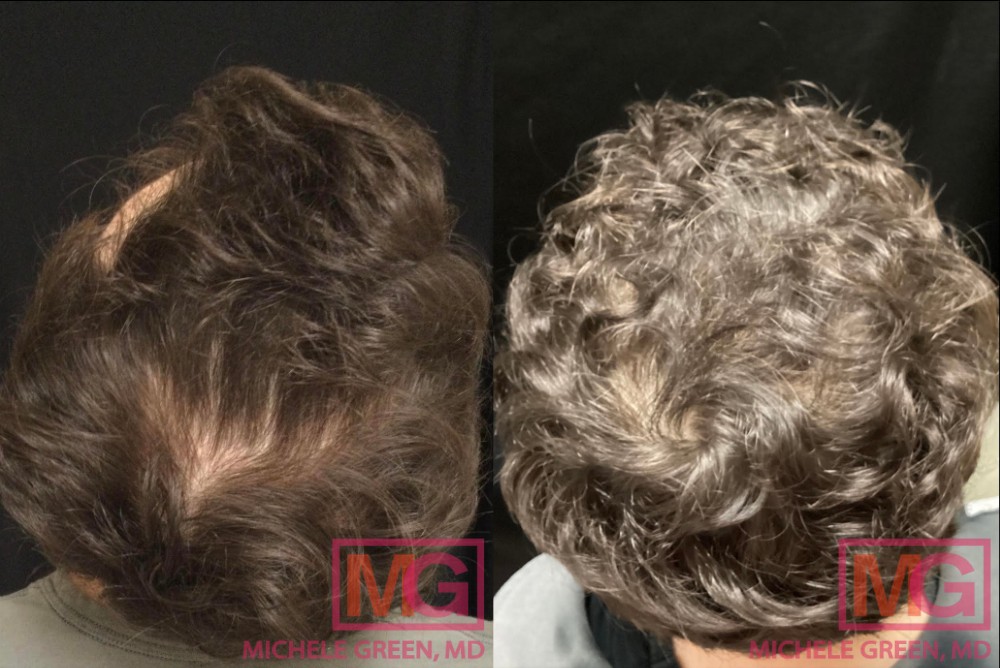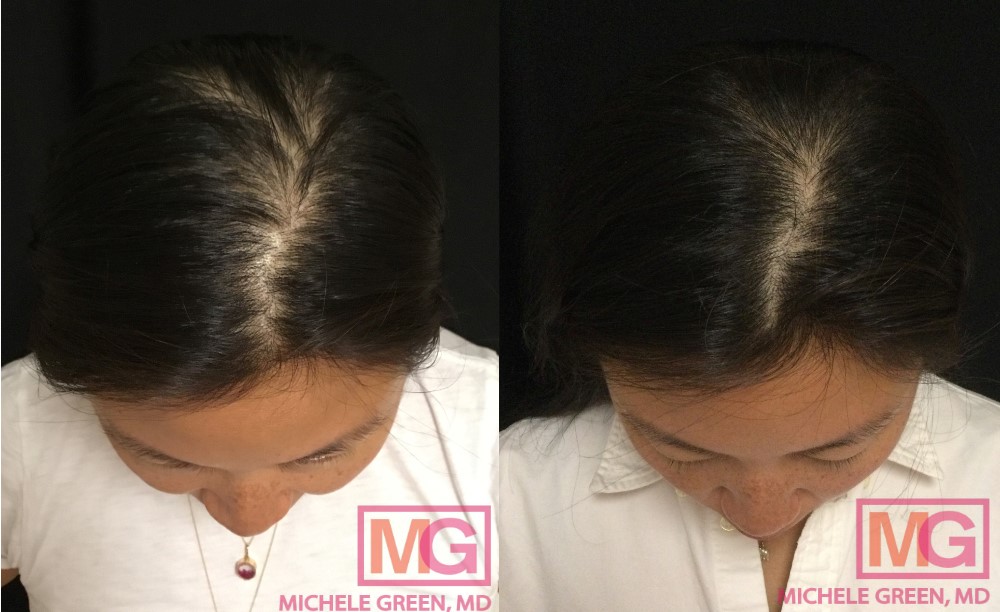Does Low Testosterone Cause Hair Loss?
Male pattern baldness or female pattern baldness, known medically as androgenetic alopecia, is a hair loss condition that affects more than 50 million men and as many as 30 million women, a statistic reported by the National Institute of Health. Though incredibly common, hair loss conditions like androgenic alopecia can cause severe distress and decrease emotional well-being. Characterized by an M-shaped receding hairline with a bald spot on the crown in men and hair thinning along the part in women, male and female pattern hair loss occurs primarily due to a genetic predisposition for hair loss. Many patients believe that one of the significant causes of hair loss is low testosterone levels. However, the reality of the situation is more complex. The first step to treating hair loss is to determine the type of hair loss and its root cause. When you have your first appointment with board-certified dermatologist Dr. Michele Green, she will examine the treatment area and determine the treatment option that will be the most effective for you.
Testosterone is an androgen hormone that does not directly cause hair loss. However, testosterone can convert into dihydrotestosterone (DHT), another hormone that can indirectly cause hair loss. DHT can bind to and damage hair follicles, resulting in hair follicle miniaturization and male or female pattern baldness acceleration. If this is the case, oral DHT blockers like Finasteride or Dutasteride may be prescribed to reduce DHT levels and hair loss. Female patients can benefit from Spironolactone, an oral medication that regulates androgen hormones like DHT. Minoxidil can be used topically or orally to strengthen hair follicles for increased thickness and growth. Additionally, patients can undergo platelet-rich plasma (PRP) injections, a new and innovative treatment option used to improve tissue regeneration and healing and prevent hair loss. Whether your hair loss is accelerated by testosterone and DHT or caused by another factor, Dr. Green is here to help.
With over 25 years of experience treating a wide range of medical and cosmetic dermatological concerns, board-certified dermatologist Dr. Michele Green is an expert in treating her patients with the most innovative non-invasive procedures, including PRP injections for hair loss. Dr. Green has been recognized for her exceptional work in Castle Connolly, Super Doctors, The New York Times, and New York Magazine due to her expertise and dedication to her patients. When you consult with Dr. Green, she will assess your medical history, hair loss, and aesthetic goals to devise the best treatment option to help you grow thicker, denser hair.
What is testosterone? What is Dihydrotestosterone (DHT)?
Testosterone is an androgen or male sex hormone found in the body. Males naturally have higher testosterone levels than females, though everyone has some form of testosterone. In the body, free testosterone exists, which is not bound to any protein but instead travels around the body to be absorbed and used by different cells. When testosterone is bound to receptors on the 5-alpha reductase enzyme, it is converted into dihydrotestosterone (DHT), an androgen hormone used in the skin, hair follicles, and prostate. During puberty for patients assigned male at birth, shifting hormone levels increase DHT, which contributes to changes such as lowering the voice, body hair growth, increased production of sperm, and testicle growth. While levels of DHT are essential for the development of the prostate, DHT can also bind to the hair follicles, affecting the growth cycle of the hair and causing the hair to become finer until the follicle ceases to produce new hair growth. However, high levels of DHT do not necessarily mean that a patient will experience hair loss. Instead, the sensitivity of the hair follicles to DHT, which is genetically determined, will determine whether hair loss will occur.
Is balding a sign of low or high testosterone?
High or low testosterone levels do not directly lead to balding; hair loss is associated with the sensitivity of the hair follicles, which is genetically determined. Hair loss occurs when hair follicles shrink, thinning to the point where the hair growth cycle ceases and the hair follicle becomes dormant. This condition is known as androgenic alopecia and can affect both men (male pattern baldness) and women (female pattern baldness), though it most commonly occurs in men. Male pattern baldness begins with frontal hairline thinning until it recedes into an M-shape. As this happens, the hair starts to thin on the top of the head, leading to hair loss at the crown. Over time, the hair loss becomes so severe that these two areas converge until only a U-shape of hair remains around the outside of the head. Female pattern baldness typically appears in a “Christmas tree” shape, with thinning beginning along the part that worsens and expands outward. The most significant risk factor for experiencing androgenetic alopecia is having a family history of the condition rather than the level of testosterone present in the body. High testosterone levels can contribute to the increased production of the hormone DHT, which can bind onto the hair follicle, weakening and causing hair loss. However, the testosterone level does not determine how sensitive the hair follicle is to DHT. Some patients genetically have a higher sensitivity to DHT, meaning high levels of DHT can accelerate the hair loss process.
Does low testosterone cause hair loss?
Hormone imbalance can affect a patient’s day-to-day ability to function at their highest capacity. Signs of low testosterone levels (or “low T”) include loss of muscle mass, weight gain, erectile dysfunction, low energy levels, low sex drive, and even depression. As men age, testosterone production naturally decreases and can affect body and facial hair growth. Still, researchers have not found a link between low testosterone levels and hair loss on the crown of the head. The primary cause of hair loss is a genetic sensitivity to the binding of DHT to the hair follicles. Patients with low testosterone often undergo hormone replacement therapy to replenish and increase the amount of testosterone in the body, which could increase DHT levels and lead to weaker, thinner hair follicles. As such, low testosterone levels are not directly related to hair loss.

Does low testosterone mean low DHT?
Yes, low testosterone results in lower levels of free testosterone, which is ready to be converted to DHT. As such, DHT levels typically decline as a result of low testosterone. Although DHT can accelerate hair thinning and loss, the primary cause of hair loss is a pregenetic disposition, and patients with low testosterone can still experience hair loss.
Does hair loss from low testosterone grow back?
Hair loss can be extremely frustrating and distressing for patients, causing many to seek hair regrowth treatment. Luckily, Dr. Green has several treatment options available at her New York City dermatology office to help restore strength to the hair follicles, thicken the hair, and promote new growth without requiring an invasive surgical hair transplant. Often, a combination of topical therapies, oral medications, and in-office treatments like platelet-rich plasma injections is best for curbing hair thinning and regrowing hair.
Minoxidil
Minoxidil is a medication that increases circulation and blood flow to the scalp, helping to thicken hair follicles that DHT may have weakened. Topical Minoxidil is FDA-approved for androgenetic alopecia treatment and can be found over the counter, typically as a foam or solution. Oral Minoxidil was initially FDA-approved to treat high blood pressure but has since been used off-label to treat male and female pattern baldness. Research suggests that oral Minoxidil may prolong the growth phase of the hair follicle, allowing hair to grow longer and for an extended period.
Finasteride
Finasteride, also known by its brand name Propecia, is a 5-alpha reductase inhibitor. By reducing levels of this enzyme, testosterone conversion to DHT is slowed, resulting in lower DHT levels. Finasteride can decrease DHT production by up to 70%, significantly slowing hair loss in most male patients. Studies have shown that Finasteride consistently decreases hair loss compared to patients who do not take the medication.
Dutasteride
Dutasteride is another 5-alpha reductase inhibitor that indirectly reduces DHT levels and thickens hair. Its effectiveness in treating androgenetic alopecia is highly comparable to that of Finasteride. However, some research suggests it may be more effective than Finasteride, as it can inhibit Type 1 and Type 2 5-alpha reductase isoenzymes, while Finasteride only blocks Type 2.
Spironolactone
Spironolactone is an FDA-approved anti-androgenic oral medication commonly prescribed to treat female pattern baldness. Spironolactone works to regulate androgen hormone levels and is particularly useful for women experiencing hormonal fluctuations and hair loss as a result of Polycystic Ovary Syndrome (PCOS).

Platelet-rich plasma (PRP) injections to reverse hair loss
Platelet-rich plasma (PRP) injections are a unique, effective hair restoration treatment available at Dr. Green’s office that helps reverse signs of hair loss. PRP contains growth factors and proteins that promote tissue healing, growth, and hair follicle thickening. PRP injections are derived from a sample of the patient’s blood, making them 100% safe. The procedure begins with Dr. Green drawing blood and using a centrifuge to separate the platelet-rich plasma from the other blood components. The PRP solution is then injected into the scalp to increase the number of hair follicles, increase the thickness of hair follicles, and strengthen the root of the hair. Patients often require four initial treatments spaced one month apart, followed by regular maintenance sessions to keep and enhance the restorative results from treatment.
What vitamin am I lacking if my hair is falling out?
Many patients wonder if a vitamin deficiency may be contributing to hair loss. Vitamin deficiencies typically are not the root cause of hair loss, but they can help promote healthy hair and regrowth. Biotin, or vitamin B supplements, can be taken while taking testosterone to maintain the strength of the hair follicles. However, Vitamin B supplements are less effective than prescription medications such as Minoxidil or Finasteride and should be used with medications and PRP injections for the best results.
How to fix low testosterone
Low testosterone levels can cause many issues, including decreased bone density, muscle mass, and strength, inability to sleep, erectile dysfunction, low sex drive, weight gain, and decreased mental and emotional wellness. Low testosterone treatment can include testosterone replacement through injections, pellets, creams, and patches. For injectable testosterone replacement therapy, the testosterone is injected directly under the skin or into a muscle for absorption by the body. Gels are rubbed onto and absorbed through your skin, though a potential side effect of the treatment is skin irritation and transference of the medication to another should they rub up against the treatment area. Patches can be applied to the thigh or torso nightly, whereas pellets must be surgically implanted under the skin every 3-6 months. No matter how it is administered, testosterone replacement therapy can benefit patients with low testosterone levels and will not directly cause hair loss or male pattern baldness.
Does testosterone replacement cause hair loss?
Testosterone replacement therapy is designed to raise testosterone levels in patients with Low T to normal blood levels. Some patients worry that increased levels of testosterone in the body can contribute to hair loss and male pattern baldness. However, that is not necessarily true. Hair loss occurs when the hair follicles become thinner and weaker, eventually entering a permanent resting phase and causing the hair to fall out. When androgen levels increase in the body, the production of DHT by the 5-alpha reductase enzyme rises, which can be a risk factor for patients genetically susceptible to hair loss. The DHT binds to the hair follicle, causing them to weaken and accelerating the hair-thinning process. However, the sensitivity of the hair follicles to DHT is not caused by testosterone or DHT but by genetics. As such, increasing testosterone levels in the body does not cause hair loss, but it can accelerate the process already in motion.

Do testosterone supplements cause hair loss?
Testosterone supplements can be prescribed for patients experiencing low levels of testosterone and can take the form of injections, a gel, patches, or pellets surgically implanted under the skin. While testosterone supplements can increase the levels of DHT found in the body, they are not directly linked to hair loss. When DHT binds to the hair follicles of patients with high hair follicle sensitivity, the hair follicle becomes weaker and thinner, eventually dormant, causing hair thinning to occur. Patients with hair follicle sensitivity may experience accelerated hair loss when taking testosterone supplements.
Does high testosterone cause hair loss?
One common assumption among patients is that high testosterone levels directly cause hair loss, but the true answer is more complex. High testosterone levels in the body may increase DHT production, accelerating hair loss for patients genetically susceptible to balding. While high testosterone or DHT levels do not directly cause hair loss, high DHT levels have been linked with medical conditions such as prostate cancer and benign prostatic hyperplasia.
Will my hair grow back if I stop testosterone?
No, hair loss is not directly caused by testosterone levels but results from a pregenetic predisposition to hair loss. Testosterone can indirectly increase hair loss through its conversion to DHT, which damages hair follicles and increases their miniaturization. Stopping testosterone replacement or supplements may decrease DHT levels and slow hair loss, but it will not change the root cause of hair loss, which is genetics.
How to prevent hair loss while taking testosterone
Instead of stopping testosterone, it is best to consult with a board-certified dermatologist like Dr. Green on preventing hair loss. Oral medications like Finasteride and Dutasteride inhibit 5-alpha reductase activity to reduce DHT levels and thicken hair. Topical Minoxidil can reverse hair follicle miniaturization and increase the flow of necessary oxygen and nutrients to the scalp. Oral Minoxidil can be prescribed off-label to treat androgenetic alopecia and promote hair growth. Spironolactone, an anti-androgenic oral medication, is commonly prescribed for women experiencing hair loss as a result of PCOS. PRP injections are an excellent addition to a hair loss treatment plan because they promote hair thickening and regrowth. When you consult with Dr. Green in her private NYC dermatology office, she will assess your medical history and hair concerns to tailor a treatment plan to help you achieve thicker, fuller hair that lasts.

What causes high DHT levels in females?
Several conditions can lead to increased levels of DHT in female patients at birth, including menopause, overactive thyroid, testosterone supplements, polycystic ovarian syndrome, and congenital adrenal hyperplasia. As women go through menopause, the body decreases the production of female expression hormones like estrogen, increasing the production of androgens, such as testosterone. When testosterone levels increase in the body, DHT levels increase as well. The same applies to testosterone supplements, which raise DHT levels and have additional side effects, including acne breakouts, chest hair growth, male pattern baldness, and lowering of voice. Polycystic ovarian syndrome is another condition that contributes to high DHT levels in females and occurs when the ovaries overproduce androgens, such as testosterone. When polycystic ovarian syndrome occurs, and testosterone levels rise, additional side effects may include acne breakouts, body hair growth, and irregular menstruation.
What causes high DHT levels in males?
High DHT levels in males are typically a result of high testosterone levels in the body that are more readily converted to DHT. High testosterone can be a marker of more serious medical conditions, including benign prostatic hyperplasia or prostate cancers. Some patients may also have a genetic predisposition to synthesize increased levels of testosterone.
Will reducing DHT regrow hair?
Yes, reducing DHT levels has clinically been proven to help regrow hair. Medications like Finasteride and Dutasteride work to inhibit 5-alpha reductase activity, reducing the conversion of testosterone to DHT and lowering DHT levels. Clinical studies with Finasteride have displayed an increase in hair growth of 48% after one year and 66% after two years, with 83% of participants stating they had no increased hair loss after starting the medication. Clinical trials studying Dutasteride have found that it significantly improves hair growth after just six months, and some trials even suggest that Dutasteride may be more effective in regrowing hair than Finasteride. Spironolactone is another medication that regulates and decreases androgen hormone levels, including DHT, to treat hair loss in women. In clinical studies, Spironolactone has been shown to increase hair loss by 64%. If you are experiencing hair thinning or shedding, it is best to consult with board-certified dermatologist Dr. Green to see if a DHT-blocking medication is proper for you.
How to tell if your hair is thinning: male and female pattern hair loss
Male and female pattern hair loss often has a predictable pattern in the way it is present on the scalp. Male pattern hair loss typically begins with a receding hairline and hair thinning above the temples and at the crown. As hair thinning worsens, the receding hairline creates the classic “M” shape and continues to recede until it meets the bald spot at the crown of the scalp and creates a horseshoe-shaped pattern of hair. Female pattern hair loss typically presents as thinning along the part that appears to be widening. The thinning then expands outwards across the scalp. Some individuals may experience hair thinning or loss through excessive shedding or the loss of more than 100 hair strands a day from the scalp. As patients look at their hair daily, knowing if you are experiencing true hair thinning can be challenging. If you are unsure if your hair is thinning or have noticed signs of male or female pattern hair loss, schedule a consultation with Dr. Green today. It is essential to start treatment as soon as hair loss occurs to prevent further hair loss and thicken and regrow hair effectively. When you consult Dr. Green, she will devise a combination treatment plan to leave you with thick, healthy, full hair again.
How to get started with hair loss treatment today
Androgenetic alopecia is a type of hair loss that occurs when an increase in androgen hormones leads to increased levels of dihydrotestosterone (DHT), which binds to hair follicles and weakens them. As the hair follicles become weaker, the hair begins to thin, leading to a receding hairline and balding at the crown of the head. Any type of hair loss is distressing, but with androgenetic alopecia, the underlying cause of hair loss is genetic, meaning that it cannot be entirely prevented. That said, the signs of hair loss can be slowed and reversed with several treatment options available at Dr. Green’s dermatology office. Topical and oral Minoxidil and PRP injections can help strengthen the hair follicle and prolong the growth phase, resulting in thicker, longer hair. DHT blockers, such as Finasteride, Dutasteride, and Spironolactone, can be used to prevent the formation of DHT, which decelerates the rate of hair loss over time. No matter the underlying cause of hair loss, Dr. Green has solutions to protect you from significant hair loss. The best place to start is by consulting with a board-certified dermatologist, such as Dr. Green.
Dr. Michele Green is a world-renowned, board-certified dermatologist with over two and a half decades of experience diagnosing and treating hair loss and thinning. Always at the forefront of innovative treatment options, Dr. Green has helped some of the world’s most discerning individuals with customized hair loss treatment plans best suited to their specific concerns and ideal aesthetic goals. She is consistently rated as one of New York City’s best dermatologists by Super Doctors, Castle Connolly, The New York Times, and New York Magazine for her dedication to her patients and expertise. When you consult with Dr. Green at her private Upper East Side dermatology office, she will work with you to better understand and treat your hair loss for thicker, healthier hair that lasts. Contact us online or call 212-535-3088 to schedule a consultation with Dr. Green and learn more about effective treatment options for hair loss.
 212-535-3088
212-535-3088